Van Gogh Museum Journal 1997-1998
(1998)– [tijdschrift] Van Gogh Museum Journal–
[pagina 104]
| |
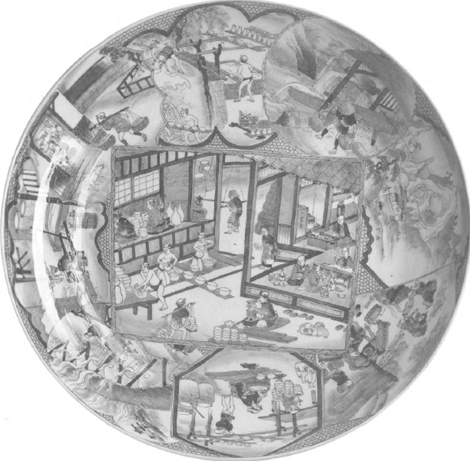 fig. 1
Blue and white Japanese dish with scenes from a pottery, The Hague, Museum Mesdag | |
[pagina 105]
| |
‘A large Japanese blue and white dish depicting a porcelain factory’
| |
[pagina 106]
| |
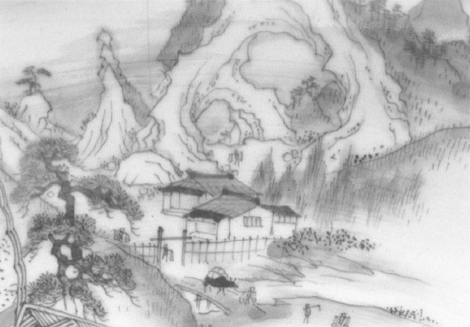 fig. 2
Detail: the quarry at Izumiyama known about the organisation of a pottery.Ga naar voetnoot4 This exactitude stands in sharp contrast to the illustration in the Nihon sankai meisan zue which incorrectly depicts a potter at his wheel. He is shown sitting cross-legged, like a tailor, whereas it is known that Arita potters traditionally sat on a raised seat and worked the wheel with their feet, as shown in the central scene of the Mesdag dish (fig. 6). In short, this piece is a finely designed snapshot from the history of porcelain manufacturing, which takes us back over 150 years to the world of a community of potters in southern Japan. | |
Scenes from a potteryThe dish is bordered by eight scenes, each contained in geometric, bracket-shaped cartouches. Moving anti-clockwise, they illustrate the porcelain-making process in a more or less chronological fashion. In the centre the main scene is framed within a rectangle. The little space not taken up by these nine illustrations is filled with a frogspawn-motif. Starting at the right (fig. 2), we see the source of the stone used to make the porcelain, the Izumiyama quarry. Located just outside Arita, today it is completely exhausted; a deep pit has been created where there once was a mountain, and the stone now extracted is used solely for roof tiles and drainpipes. In the hills around the quarry are numerous hollows, dug in search of the highest quality stone. This was necessary because the stone's characteristics varied a good | |
[pagina 107]
| |
deal. In the stone of volcanic origin, for example, which consisted mainly of quartz and mica, weathering and hydrothermal action had raised the initially low level of kaolinite and reduced that of quartz.Ga naar voetnoot5 These processes varied naturally from location to location, and over the years there was keen competition to secure the best sources. Stone from Izumiyama was not mixed with that from other quarries, but the different variants from sites within the quarry were combined to obtain the best clay for a particular purpose.Ga naar voetnoot6 Various pieces of equipment can be seen in the depiction of Izumiyama.Ga naar voetnoot7 One of the four figures carries a tsuruhashi, a pick for hewing stone. The other three transport the stone with a kind of yoke consisting of two wicker baskets hung from a pole, known in Arita as a tengonbô or ôko. The beast of burden shown, probably a horse, brings the stone the rest of the way to the manufactory. Behind them, encircled by a wooden palisade, are the buildings and guardhouse of the overseer, who was appointed by the han.Ga naar voetnoot8 The stone was crushed either by hand using a hammer or, as here, by a water-driven pounder (fig. 3). These were known as kara usu or mizu usu. The mechanism was simple but effective: the tank at the back of the horizontal beam filled with water until the weight tilted the whole; the tank emptied itself and the metal-covered pounder at the other end fell onto the box of stone. Good use was made of the many streams in the area and there were said to be over a hundred of these pounders in and around Arita.Ga naar voetnoot9 As in the other scenes, the attention to detail here is remarkable. The realistic depiction of the roof over the pounder, the clothing of the figure with his rain hat, and the baskets covered with sedge provide valuable information about everyday life in Japan at this period. The powder thus obtained (hatarikona) was then put in a suspension to purify the clay and separate the finer mica and kaolinite particles from heavier constituents such as quartz.Ga naar voetnoot10 As the water moved from one trough to another, the coarser particles were precipitated, while the smaller ones remain in suspension. Scene 4 (fig. 4) shows how the water from the first rectangular tank ran into a narrow channel, from which the clay solution was then removed with a choppage and put through a sieve (shiino)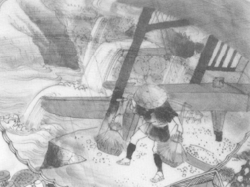 fig. 3
Detail: stone-grinding with the aid of a water-driven pounder  fig. 4
Detail: purification of the clay | |
[pagina 108]
| |
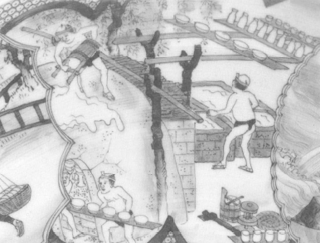 fig. 5
Detail: drying of the clay; firing the greenware before ending up in the last tank.Ga naar voetnoot11 To the right at the back are two jars used to store clay solution or glaze, also seen - with stirrer - in scene 7 (fig. 7). Hanging from a beam are two kuwa, hoes used for raking up the clay. To the right, scene 5 (fig. 5) shows the clay being dried in big stone troughs (oro). When sufficiently dry, it was laid out on absorbent tiles. Porcelain clay made of Izumiyama stone had to be left to rest for about two years before it could be used.Ga naar voetnoot12 In the left background a curious scene takes place: a man appears to be emptying a bucket over the kiln. The Nihon sankai meisan zue shows a similar scene, and remarks that the dried clay was spread over the kiln so that the heat would make the clay softer. It was then scraped off, mixed with pure water and kneaded into balls.Ga naar voetnoot13 Brinkley confirms this practice in his work of 1901: ‘The clay is finally made more consistent by putting it for a time on the warm ovens.’Ga naar voetnoot14 Biscuit firing took place at Arita from at least the 19th century, and probably earlier.Ga naar voetnoot15 Before being decorated, the greenware was fired at about 950°c. Here we clearly see the raised floor on which the pieces will be fired. The space in front, where the long planks are being carried into the kiln, is where the fire will be lit. This shows that the kiln's entrance and exit also had to serve as the stokehole. Through the door we can see the plates placed on to chin, special stands that made it possible to arrange the pieces at different heights and so make better use of the kiln's limited space.Ga naar voetnoot16 Beside the kiln are several bowls and a small rokuro or wheel, which was used for finishing off the pieces before firing. Above, the drying troughs are racks (tonpan) laden with drying greenware. The central cartouche depicts the main workshop, the heart of the factory (fig. 6). It is a busy scene: the potter's wheel spins, pigments are ground, and decorators, merchants and administrators come and go. Particularly striking - in addition, once again, to the precision of detail - is the illustration's homely atmosphere. An old woman enters with a pile of cups and a kettle of tea; on the ground | |
[pagina 109]
| |
 fig. 6
Detail: central cartouche with the decorators' workshop two dogs sleep amicably side by side; and pairs of straw sandals can be seen lying where the merchants on the raised platform have left them. It all looks rather pleasant. This scene in particular provides a great deal of information about the day-to-day routine in the manufactory. On the raised platform to the right we see two merchants inspecting the goods on offer: the one on the left opens a lidded bowl, while the one on the right holds a larger vessel. Around them various wares are set out on display: bowls, plates, a flask, a sake bottle, all with the forms and decorations one would expect in the mid-19th century, such as the bowl with the ‘fishnet pattern.’Ga naar voetnoot17 In front of them sits an employee, writing in what appears to be a notebook, and at the back of the room, next to a wooden chest marked shoko (library), sits a man who is probably the kamayaki or proprietor.Ga naar voetnoot18 He is seated behind a brazier with his pipe to the left, and his own tea-making set in a niche beside the book chest; behind him part of the tokoname is visible. In this illustration we also see various further stages in the manufacturing process. First, at the left, the clay is kneaded;Ga naar voetnoot19 to homogenise the clay and drive out the air, this needed to be carried out over an extended period of time. Here the man is working according to the so-called ‘chrysanthemum method,’ in which the lump of clay is kneaded in spiraling motions.Ga naar voetnoot20 Behind him are two figures at the kerokuroGa naar voetnoot21 or potter's wheel, driven round clockwise with the left foot. | |
[pagina 110]
| |
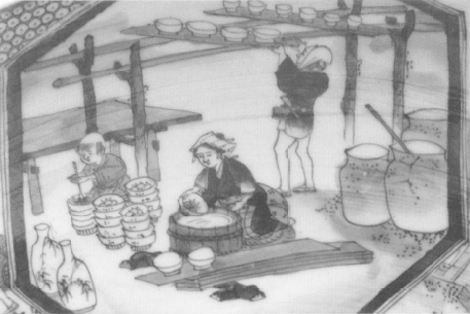 fig. 7
Detail: glazing the bowls 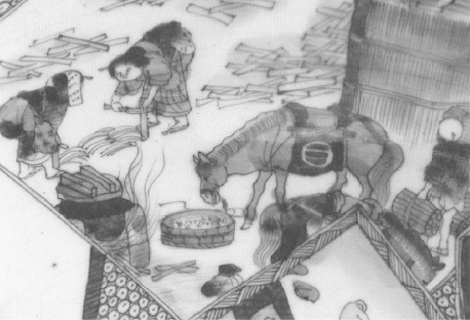 fig. 8
Detail: debarking the firewood | |
[pagina 111]
| |
This type of wheel was probably introduced to Japan from Korea at the end of the 16th century, a period when many ceramic techniques arrived from the mainland.Ga naar voetnoot22 The platform of the wheel is at about the same height as the seat, so that it could be turned with the upper body leaning forwards. After the clay was centered using both hands, a portion was worked upwards to form the bowl, as the figure on the right demonstrates. The man on the left works his bowl with a hera, a curved wooden spatula used for shaping the inside surface.Ga naar voetnoot23 At the front right bowls are being made with the help of a mould: the clay was pressed down over a form with a wooden spatula, after which the foot-ring was attached. This method produced a very regular shape, and the inner surface could be decorated with relief patterns simply by incising the wooden form. To the left sit the decorators, their brush-cases at their sides: they are turned towards the windows to make the most of the light. Their task was to paint the porcelain in cobalt blue before glazing. The woman on the left at the back is grinding cobalt oxide in a stone mortar. After being decorated the pieces were glazed, producing the typical underglaze blue. The illustration (fig. 7) shows a child using both hands to turn a toibôki round in a bowl to remove dust. The woman in the centre, beautifully depicted dressed in an apron, with a headcloth and bands holding up her sleeves, kneels on a mat as she dips the bowls in a vat of glaze. The decorations of the bowls beside her and above on the drying rack are not visible; they have already been glazed.Ga naar voetnoot24 In Arita porcelain was glazed with a mixture of wood ash and porcelain stone, a glaze that was also used on Korean stoneware, where it originated.Ga naar voetnoot25 The two women in figure 8 bend over as they work with a debarker. The most suitable fuel for the kilns was pinewood, but it was not available in large quantities, and in practice other softwoods were often used. Obtaining wood was a problem in this area of Japan; as early as 1637 an edict refers to deforestation caused by increasing consumption. The bark was removed in order to reduce the amount of ash created in the kiln during firing. It is also possible that it was used in the production of glaze. In Arita, for example, the ash of the bark of the Isu tree (Distylicum racemosum) was generally used to make glaze.Ga naar voetnoot26 In another scene (fig. 9) we see part of the kiln or noborigama. This name, literally ‘climbing kiln,’ derives from the fact that it was built in steps against a hill. In the early 19th century it usually had about 18 chambers, six of which are shown here. They are sheltered by a roof of reeds or straw. The doors of the ovens are bricked up, except for a hole through which firewood could be thrown. To the right there is another opening, used to judge the temperature by the colour of the glowing porcelain. Firing began at the bottom, in the first chamber; when the temperature reached 850°c the firing of the second chamber began. Each chamber was connected to the previous one through openings at the bottom of the wall; this allowed for the circulation of hot air, ensuring that the heat was evenly distributed.Ga naar voetnoot27 It was also essential for the success of the underglaze blue that firing take place under the extraction of oxygen. To achieve this, fresh wood had to be thrown onto the fire regularly; in the first stage of combustion the fresh wood consumed oxygen, thus removing it from the surrounding areas. When the chamber reached the required temperature (1280°c), the stokehole was closed in order to maintain the reduced atmosphere. Once the whole kiln had been fired, it was left to cool down for several days. It was important that the temperature rise and fall slowly, in order to prevent damage being caused by sudden cooling. Here we see wooden blocks being thrown into the kiln through the stokehole. A child stands by the woodpile, ready to hand over the next block, and the overseer quietly smokes his pipe. At the bottom left one can catch a glimpse of how the wood was transported. | |
[pagina 112]
| |
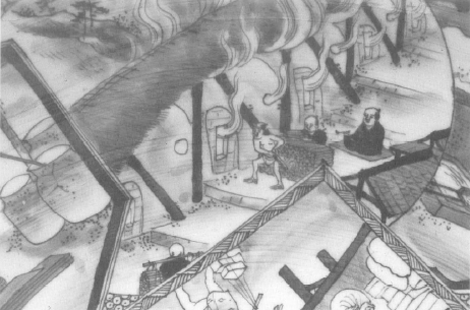 fig. 9
Detail: the kiln 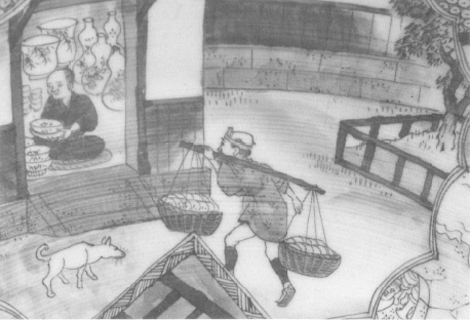 fig. 10
Detail: goods being stored in the warehouse | |
[pagina 113]
| |
In the last scene (fig. 10) the finished products are brought into the warehouse. The bearer moves towards the doorway carrying two baskets of bowls. Inside a man appears to be carrying out a final inspection. Double-gourd bottles and large pots are visible behind him. | |
A craftsman's statement?It is extraordinary how the decorator has managed to cover so many aspects of porcelain manufacturing in just nine scenes. He has given us a remarkably detailed picture of the process, although not, of course, an all-embracing one. Overglaze decoration in colour, for example, is not shown. It is almost as if the dish has been limited to a kind of self-reference, to telling the story of its own genesis. Nonetheless, there is a great deal of information and we are given a good insight into the daily routine at the pottery. Beyond this informative content, however, it is the affection with which the painter has depicted his subject that makes this dish so appealing. As mentioned above, one other example of this dish is known, in the museum in Arita. It is interesting note its few minor differences from the Mesdag dish. On the dish in Arita the block of wood is thrown into the kiln with the left hand; on the dish in The Hague with the right. On the latter the administrator writes with a brush, whereas on the Arita example he rubs an ink stick on an inkstone. But the most striking difference is in the central scene: in the Arita example a small boy stands beside the raised platform where the decorators are seen working (fig. 11). He appears to be talking to an elderly gentleman wearing glasses, who is seated at the end of the row and may be assumed to be the senior craftsman. Surprisingly, on the Mesdag dish the place of the old man has been taken by the man who once sat at his left. Could it be that he has surrendered his place to the new generation? In any event it is very tempting to date the Mesdag dish a few months later than the Arita example on the grounds of this transposition. 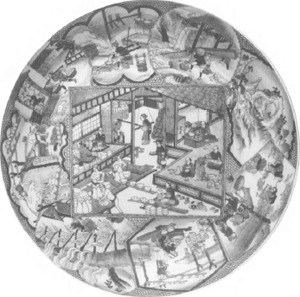 fig. 11
Blue and white Japanese dish with scenes from a pottery, Arita, Arita Ceramic Museum |
|

